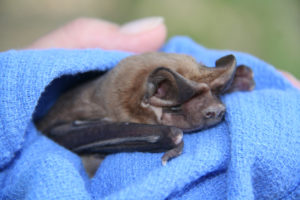
Hi everyone! I hope you all had a good week. Mine was fun because I have a friend visiting, so I’ve been doing a lot of sightseeing. There was a hurricane in the southeastern United States this week. The state of Florida was hit very hard. This week’s blog is dedicated to everyone affected by Hurricane Michael, not only in Florida, but also in Alabama, Georgia, North and South Carolina, and Virginia. I did a little bit of research and discovered that Florida’s largest bat is the Florida bonneted bat. I wrote about this bat a couple of years ago, but I thought it was worth refreshing everyone’s memories on this adorable bat. This bat is listed as endangered by the USFWS and is believed to be the rarest bat in the world. The Florida bonneted bat is large with a long tail membrane. It can be 6.5 inches long with a wingspan of 20 inches. Its ears join at the base. The bats’ fur is black, brown, gray, or cinnamon brown. Not much is known about this bat because it is so rare. They only live in a few counties in south Florida and only a few nursery roosts have been found. Loss of habitat is the Florida bonneted bats’ greatest threat. Habitat loss for this species comes in the form of human destruction of its roosting sites as well as natural disasters such as hurricanes. If you would like to read more about the Florida bonneted bat, you can find information here. In other batty news, there will be a bat event at Huntley Meadows Park in Alexandria, VA tonight at 7:00 PM. I am going to try to make it. Mrs. Sturges will definitely be there with some of our bat friends. If you are in the […]
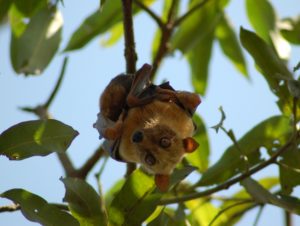
Hi everyone! I hope you all had a good week! Things went from bad to worse in Indonesia this week. After having both an earthquake and a tsunami last week, a total of three volcanoes erupted this week. These volcanoes are spewing ash into the sky, which makes it difficult to breathe. Once again, I would like to dedicate my blog to the people of Indonesia. I hope things improve for you all very soon. Our esteemed leader, Mrs. Sturges, suggested that I write about the Sulawesi flying fox. The Sulawesi flying fox lives on the islands of Sulawesi and Buton. Sulawesi is the island where there was the earthquake and tsunami. This adorable flying fox has yellow-orange fur and long noses that are perfect for munching on fruit and sucking up pollen. They have big eyes compared to microbats. Sulawesi flying foxes like to eat coconuts, breadfruits, and their favorite, pollen from eucalyptus blossoms. Like a lot of other megabats, Sulawesi flying foxes roost in trees. They are often found hanging in mangrove forests. These bats will sometimes share the trees that they are roosting in with black flying foxes. It works out perfectly for the bats because black flying foxes prefer lower branches and Sulawesi flying foxes like to be up high. Sadly, these bats are listed as vulnerable because of hunting. A lot of Sulawesi roosting trees are being cut down which leaves them unprotected. Sulawesi flying foxes are completely extinct in North Sulawesi because of the hunters. If you would like to read more about the Sulawesi flying fox, you can find information here. I would like to remind everyone that there is another batty event on Saturday, October 13 at 7:00 PM. This event will be at Huntley Meadows Park in Alexandria, VA. Mrs. Sturges […]
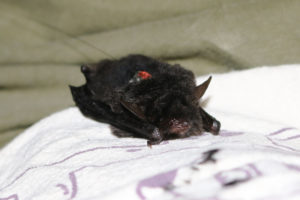
Hi everyone! I hope you all had a good week! The best part of mine was the holiday on Monday. It was nice to sleep late and relax. There was a powerful earthquake in Japan on Thursday. I would like to dedicate this week’s blog to the people of Japan. My thoughts are with you all as you recover from this earthquake. I read about an adorable Japanese bat called the Yanbaru Whiskered bat. These bats have black fur over most of their body, with some hairs having silver colored tips. This bat was first discovered in 1996 and has been listed as critically endangered by the International Union for Conservation of Nature. This is because its habitat is only 39 square miles of land. The Yanbaru Whiskered bat is only found on a few of Japan’s islands: three of the islands of the Ryukyu Archipelago, Okinawa, Amami Oshima, and Tokunoshima. This bat roosts in hollow trees. Because this bat’s habitat range is so small, deforestation is a major threat. If you would like to read more about the Yanbaru Whiskered bat, you can find information here. As you are making your plans for the rest of the month, please consider attending Herndon’s Naturefest. It will be on September 23 from 1-5:00 at Runnymede Park in Herndon, VA. Save Lucy’s esteemed leader, Mrs. Sturges, and I will both be there. And best of all, Mrs. Sturges will bring some of our batty friends. I hope you all have a good week.
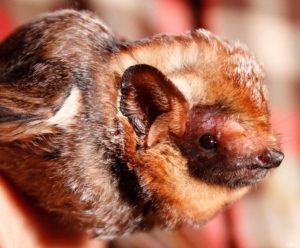
Hi everyone! I hope you all had a good week! I had a fun week, but sadly, it is now over. School starts on Tuesday, and I am not ready to start getting up early again. It’ll be nice to see my friends, but I do wish school could start a nice 2 or 3 hours later. Wouldn’t that be nice? There is currently a hurricane heading toward the islands of Hawaii. I thought I would write about a bat that lives there. As it turns out, Hawaii’s native bat, the Hawaiian Hoary Bat, is the only native land mammal to Hawaii. Sadly, the Hawaiian Hoary Bat has been on the endangered species list since 1970. Like many of the bats on the endangered list, this bat’s problems are due to deforestation and pesticide use. This bat likes to eat insects and lives in the forests of the islands of Kauai, Maui, the Big Island of Hawaii, Oahu, Molokai, and Koolawe. The bat has only recently been confirmed on Koolawe. The Hawaiian Hoary Bat is brown/grey colored and has white tips on their extremities. The bats are about 6 inches long and weigh about an ounce. If you would like to read more about the Hawaiian Hoary Bat, you can find information here.
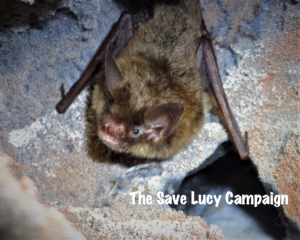
Hi everyone! I hope you all had a good week. It was nice and relaxing. I wish it could be summer all year long! I found an article about the Northern Long-eared Bats in Wyoming. These bats are on the endangered species list and need all they help that they can get from bigger creatures like us. A group of bat researchers from the University of Wyoming drove out to the Black Hills in order to study these bats. This can be very difficult because bats are agile flyers and don’t like to be caught in nets. The bats aren’t hurt and are released as soon as they are fitted with transmitters. This study was important because the researchers are looking at where the bats live, and if any of them has come into contact with the fungus that causes White Nose Syndrome. In addition to the Northern Long-eared Bats they were there to study, researchers also found Western Small-footed, Little Brown, Big Brown, Hoary bats. One of the bats they found was a mother Northern Long-eared Bat. Luckily, White Nose Syndrome hasn’t been found in the area’s Northern Long-eared Bats, but it has been spotted less than 200 miles away in Fort Laramie, and Jewel Cave National Monument in South Dakota which is only 65 miles away. The researchers needed to study these bats because there is a logging team nearby. They were worried because the loggers are chopping down ponderosa pine trees, which are very important to the area’s Northern Long-eared Bats because they are used for maternity roosts. In order to make sure that the loggers don’t cut down any trees being used by the bats, researchers capture the mothers, glue trackers on their backs, and follow them back to their homes. The researchers were happy to […]
Hi everyone! I hope you all had a good week! I did because yesterday was King’s Day in the Netherlands. Since I am part Dutch, I celebrated the day with some Dutch pancakes and a yummy Dutch cake. King’s Day is the birthday of the Dutch King. So, I would like to wish His Majesty, King Willem-Alexander a very happy birthday. I hope everyone in the Netherlands and Dutch people all over the world had a fantastic holiday. Since it was the King’s birthday yesterday, I thought that I would write about a bat from the Netherlands. I found an adorable bat called the Pond Bat. They are so cute! They have ash-grey or chestnut-brown fur on their backs, and their stomachs are covered with greyish fur. They live all over Europe and part of Asia. Pond bats roost in hollows in trees, caves, and comfy human house roofs and church towers. As their name suggests, they like living near water. They dive toward the water and catch gnats, midges, and caddis flies…I think the Bat Scouts could have a new Bat Scout cookie, because…eww! Like many other bats, these adorable critters are in danger. Many of their nursery sites have been lost in the western part of their range. They are doing a little better in the eastern part of their range, but they are still near threatened there. If you would like to read more about Pond Bats, you can find information here.
[ngg_images source=”galleries” container_ids=”5″ display_type=”photocrati-nextgen_basic_slideshow” gallery_width=”600″ gallery_height=”400″ cycle_effect=”fade” cycle_interval=”5″ show_thumbnail_link=”0″ thumbnail_link_text=”Bats of WNS” order_by=”sortorder” order_direction=”ASC” returns=”included” maximum_entity_count=”500″] The images above are white nose species we have hosted at Save Lucy. Not all species are imperiled equally, but all of them, even the more common ones, are in need of conservation action. — Ed. Hi everyone! I hope you all had a good week. Mine started off well because it was Easter. I like Easter! I got to eat a lot of candy and candy makes me happy. Sadly, my wonderful vacation and holiday had to come to an end. I went to school on Tuesday. I had to give a 10-minute speech in my English class on Wednesday. I also had exams. It was awful! Something else happened this week that was even more awful than my suffering. The fungus that causes White Nose Syndrome has been found in two new places. First, it was found in Kansas. Kansas is the 32nd state that the fungus has been found in. Several bats were found to have the disease in Cherokee County in Southeast Kansas and in Barber County in South central Kansas. This news made me very sad. As if that wasn’t bad enough, the fungus has now been found in Central Texas. It was found in the Panhandle of Texas last year and it seems to be spreading. It has now been found in 4 new Texas counties. They found the fungus on cave bats, tri-colored bats, Townsend’s big-eared bats, and on a Mexican free-tailed bat. The detection of the fungus on a Mexican free-tailed bat was particularly worrisome. Scientists don’t think these bats are susceptible to WNS, but since they migrate in such large numbers, they are worried the disease could spread further. If you would like to read […]
Hi everyone! I hope you all had a good week. I was sad on Thursday because it had snowed the night before, and I STILL HAD SCHOOL!!! There was at least half a millimeter of snow on the cars when I woke up in the morning. The sidewalks were damp. It was obvious to all Fairfax County Public School students that there should at least be a delay. I mean, they’ve cancelled school for less in the past. But, nothing! I had to go to school on time! The injustice of it all was overwhelming! Ok, I feel better now… I have some good news in the world of bats! Scientists might be on the verge of a breakthrough in eradicating White Nose Syndrome! As many of you know, the fungus most likely began in Eurasia, and the bats over there seem to be immune to it. The bats here in North America, however, are not. Little Brown bat populations have dropped 90 percent since White Nose Syndrome first appeared in New York. And, Tricolored and Northern-long Eared bat populations have dropped 97 percent. White Nose Syndrome even snuck its way west of the Rockies. There has been no news of any hope for a cure except for relying on time and evolution, until now. Hundreds of researchers have been trying for years to find a way to stop, or at least slow down, this deadly disease, with no luck. New research is beginning to show some hope of a solution. A study led by the U.S. Fish and Wildlife Service has been looking into the genomics of the fungus that causes White Nose Syndrome. They have discovered that this fungus is missing an enzyme that allows it to repair its DNA after it’s been exposed to UV light. They are […]
Hi everyone! I hope you all had a good week and a very Merry Christmas! I had an awesome Christmas and I got some really cool presents. I even got a brand new Save Lucy t-shirt! Since this will be my last blog post of the year, I thought it would be nice to look back at everything that happened in 2017. I know a lot of bad things happened in 2017. White Nose Syndrome continued to spread, sadly with no end in sight. There were hurricanes, earthquakes, and wildfires. More than half of Puerto Rico is still without power. Honestly, it’s been a rough year for a lot of people and a lot of critters. That said, some good things happened too. So, let’s focus on the good… On January 24, Fiona the Hippo was born at the Cincinnati Zoo. She soon became an international internet sensation bringing joy to millions of people around the world. She is absolutely adorable! A 12 year old Romanian boy risked his life to save the life of a toddler who had become trapped in a pipe. There was a total solar eclipse seen throughout North America on August 21. There won’t be another seen on the continent until 2024. And in bat news, a new bat was discovered roosting in East Devon. The grey long-eared bat is rare to the UK. There are only about 3,000 of them, so this discovery was great news! More good news came out of Europe in 2017. Thanks to Europe’s strict laws protecting bats, it was found that European bats are making a comeback. Many bat populations on the continent have increased by 43% since 1993. And last but not least, Northern Long-Eared bats were found on the island of Nantucket, Massachusetts and coastal South Carolina. […]
Baturday News is a weekly blog written by Rachael, a high school student, bat advocate, and Save Lucy volunteer. Rachael’s interest in bats was sparked by the big brown bats that used the outside of her former home for a winter roost. She now enjoys watching the bats fly over her home on summer evenings. Rachael has been writing the Baturday News for over three years. Hi everyone! I hope you all had a good week. I have been sick! Just in case you guys are curious, pneumonia stinks! I would not recommend it. In fact, if there is a way you can avoid it, I would highly recommend that you do so. I am happy to say that the antibiotics are working and I am starting to feel a little better now. It has been another difficult week for Puerto Rico and Mexico. Puerto Rico was hit by Hurricane Maria. Power is out to the entire island, only about a fourth of the people have water, and a dam is in “imminent danger of failing.” While Puerto Rico and other Caribbean islands were dealing with the hurricane, Mexico was hit with another major earthquake. Hundreds of people were killed. My thoughts are with the people of Puerto Rico and Mexico. With all the bad news, I thought everyone could use some good batty news. I have some great news for the Indiana bats living in Illinois. An old silica mine that was owned by the mining company Unimin has been given to the Organization for Bat Conservation. More than 45,000 endangered Indiana bats now have a nice comfy home. Apparently, bat populations living in silica mines haven’t been affected by White Nose Syndrome as much as bats living in other caves. So, the Executive Director of the Organization for […]




